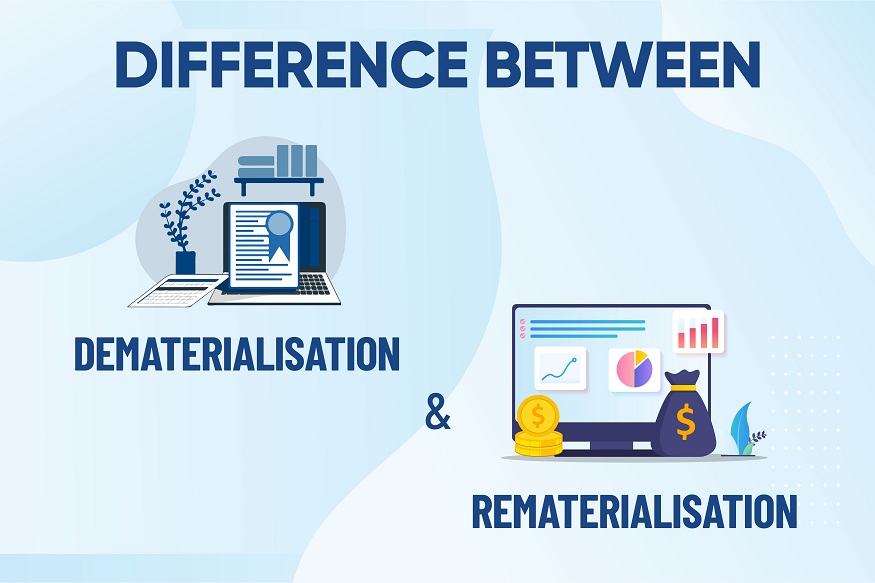The dematerialization and rematerialisation of securities are two important processes in the world of investing. Dematerialisation is the conversion of physical securities into electronic format. In contrast, rematerialisation refers to the conversion of electronic securities back to physical form. However, these processes hold significance for investors to be aware of and understand, especially for those looking to open a demat account online.

Understanding the key differences between dematerialisation and rematerialisation is crucial. Both these processes differ in various aspects such as the mode of transaction, account maintenance authority, maintenance charges, level of difficulty associated with each process, etc. In this post, let’s take a detailed look at the difference between dematerialisation and rematerialisation.
What is Dematerialisation?
Dematerialisation is the process of converting securities from physical form to electronic format. Once the securities are converted into electronic format, they are stored in a demat account for safekeeping. Also, it is necessary to dematerialise shares and securities to sell them through stock exchanges. Moreover, with the help of a demat app for Android, you can easily convert physical securities into electronic form.
What is the Dematerialization Process?
You have to submit a Dematerialization Request Form (DRF) to convert physical securities into digital form. Here is the process:
- Find a Depository Participant (DP) that provides DEMAT Services. They will help you in the dematerialisation process.
- Fill out a Dematerialisation Request Form (DRF) provided by the DP.
- Submit the DRF form along with the physical share or debenture certificates that you want to convert into digital form.
- The certificates will be marked as “Surrendered For Dematerialisation.”
- The DP will forward your request and the certificates to the Depository, Registrar, and Transfer Agent.
- The registrar will update the depository on the progress of your request. Once confirmed, your demat account will be credited with the digital certificates.
- You will be provided with a unique Demat account number and ID that will allow you to access and manage your demat account online.
- The entire setup and activation process for dematerialisation typically takes around 15 to 20 days.
What is Rematerialisation?
Rematerialisation is the process of converting digital securities back into their physical form. If investors have their securities stored in a demat account, they can opt to convert them into physical certificates by submitting a Rematerialisation Request Form (RRF) to their Depository Participant (DP).
What is the Rematerialisation Process?
Here are the simple steps involved in the rematerialisation process:
- Fill out the REMAT Request Form (RRF) provided by your Depository Participant (DP).
- Submit the RRF form to your DP. They will then forward it to the depository.
- In order to verify the forms, the depository will send them to the Registrar.
- Once verified, the Registrar will print new physical certificates for the shares or securities you want to rematerialise.
- After receiving confirmation from the Registrar, the DP will provide you with the new physical certificates.
- The entire rematerialisation process usually takes around 20 to 30 days.
Difference between Dematerialisation and Rematerialisation
After learning what dematerialization and rematerialization are, let us look at the key differences:
| Basis | Dematerialisation | Rematerialisation |
| Meaning | Converting physical shares into electronic form | Converting electronic shares into physical form |
| Share identification number | Dematerialized shares do not have distinct numbers. However, a demat account comes with a unique ID. | A distinct number is provided by RTA |
| Mode of transaction | The transaction takes place in a digital format | All transactions take place physically |
| Account Maintenance Authority | The NSDL or CSDL is responsible for account maintenance. | The company is responsible for account maintenance. |
| Annual Maintenance Charge | The maintenance charge varies between Rs. 500 and Rs.1000 | No annual maintenance charge. |
| Security | There are low threats to digital shares. | The frauds, forgery and threats are higher in paperwork. |
| Difficulty | It is an easy process. Almost every investor has gone through it at least once. | It is a difficult and time-consuming process. It can be challenging and may require the help of experts. |
Conclusion
Dematerialisation and rematerialisation are two processes with significant differences. Dematerialisation involves converting physical securities into electronic form, while rematerialisation reverses this process by converting electronic securities back into physical certificates. Understanding these processes is essential, particularly for individuals interested in opening a demat account online.
Moreover, there are notable differences between dematerialisation and rematerialisation. For example, dematerialisation has an annual maintenance charge, while rematerialisation does not. Additionally, digital shares have lower security risks than physical documents. Moreover, dematerialisation is generally considered easy, while rematerialisation can be more challenging. Thus, by understanding the differences between dematerialisation and rematerialisation, you can make informed decisions regarding securities and navigate the processes accordingly. However, most investors opt for convenience and prefer dematerialised securities.






Leave a Reply
You must be logged in to post a comment.